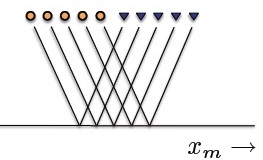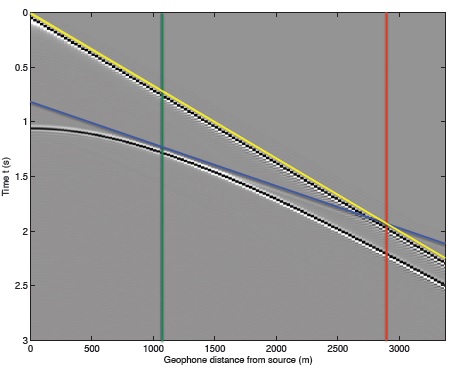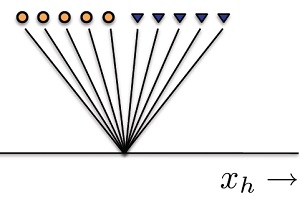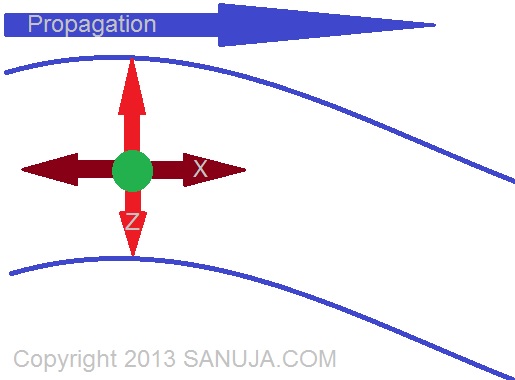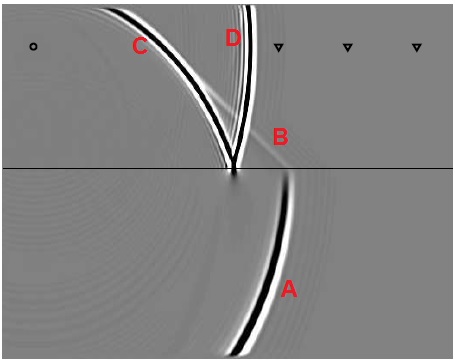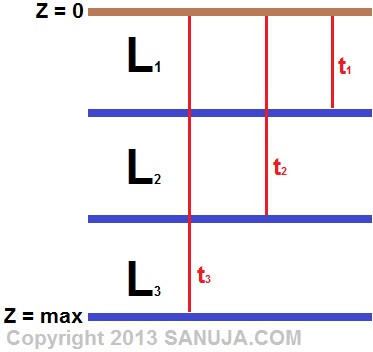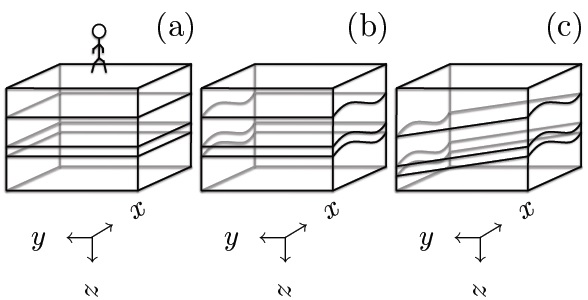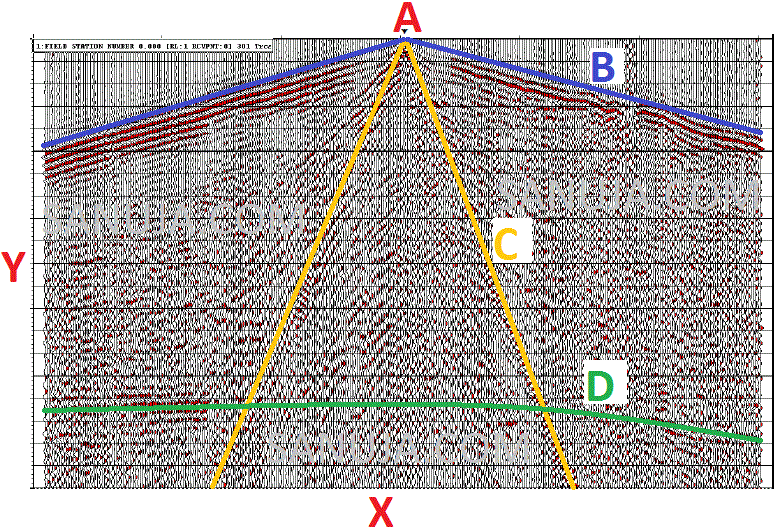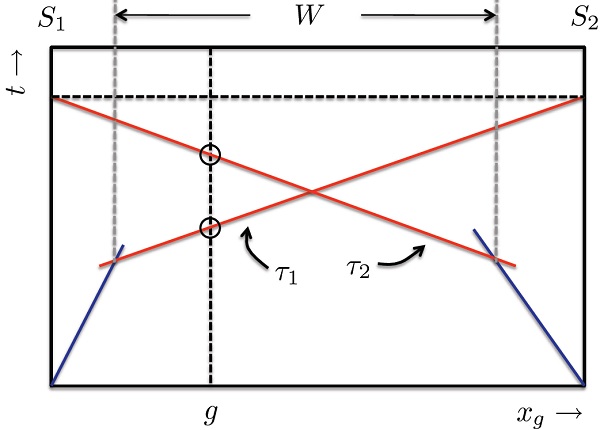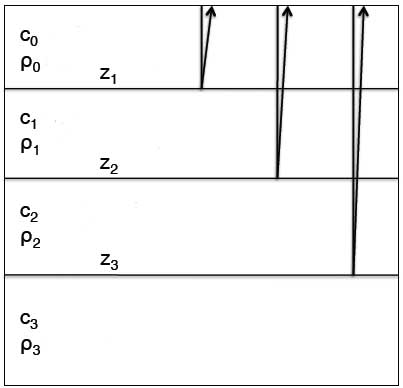Go to: Midterm II | Final
Geophysics (GOPH 355-UCAL) Midterm Exam I
Congratulations - you have completed Geophysics (GOPH 355-UCAL) Midterm Exam I.
You scored %%SCORE%% out of %%TOTAL%%.
Your performance has been rated as %%RATING%%
Question 1 |
A | The angle between the horizontal surface to the ray. |
B | Half of the angle between the incident and reflected rays. |
C | The angle between the ray and the normal to the surface. |
D | The angle between the incident and reflected rays. |
Question 2 |
A | sensors. |
B | source. |
C | shot point. |
D | receivers. |
Question 3 |
A | True |
B | False |
Question 4 |
A | Non-linear black line (bottom one) |
B | Blue line |
C | Red line |
D | Yellow line |
E | Green line |
Question 5 |
A | Common Midpoint Gather |
B | Common Offset Gather |
C | Common Receiver Gather |
D | Common Shot Gather |
Question 6 |
d = d(xg,yg,xs,ys|t)
A | The position of the geophone. |
B | The position of the ground refraction. |
C | The position of the source. |
D | Depth which the ground reflection occurs. |
Question 7 |
A | The direction of the S-wave will be changed 45-degrees to the original direction. |
B | The direction of the P-wave will be changed to 45-degrees to the original direction. |
C | The direction of the P-wave will changed 90-degrees to the original direction. |
D | The direction of the P-wave will remains the same. |
Question 8 |
A | Perpendicular to the propagation direction |
B | Red arrow; along the y-axis (up and down) |
C | All of the answers are wrong since S-wave only travels along the surface of the material (causing distortion) |
D | Brown arrow; along the x-axis (left or/to right) |
Question 9 |
A | crossline |
B | inline |
C | into the plane |
D | out of the plane |
Question 10 |
A | head wave |
B | direct wave |
C | reflected wave |
D | transmitted wave |
Question 11 |
A | transmitted wave |
B | head wave |
C | direct wave |
D | reflected wave |
Question 12 |
| Layer | CRMS (m/s) | 1-way travel time (s) |
| 1 | 2050 | 0.192 |
| 2 | 2253 | 0.226 |
| 3 | 2590 | 0.312 |
A | 2799.01 m/s |
B | 3316.19 m/s |
C | 1099.71 m/s |
D | 5604.95 m/s |
Question 13 |
A | Only one, between the refactor medium. |
B | One one, on the seismic source side. |
C | Only one, on the geophone side. |
D | Two, on both at the seismic and geophone side. |
Question 14 |
A | Deflect back up into the incident medium at about 180-degrees to the normal. |
B | Increase bending the ray away from the normal. |
C | Would reach the critical number causing the ray to travel along the boundary between the two medium. |
D | Decrease bending the ray towards the normal. |
Question 15 |
A | A |
B | None of them. |
C | B |
D | C |
Question 16 |
A | True |
B | False, because it is only applied to radioactive atoms. |
C | False, because it is only applies to particles, not atoms. |
Question 17 |
A | False |
B | True |
Question 18 |
A | False |
B | True |
Question 19 |
A | Red line |
B | Blue line |
C | Yellow line |
D | Non-linear black line (bottom one) |
E | Green line |
Question 20 |
The wave that starts at s and ends at g goes everywhere first.
But most of what is observed at g follows the path for which the travel time is a minimum.
A | Young's principle |
B | Hook's law |
C | Snell's law |
D | Fermat's principle |
Question 21 |
A | Common Receiver Gather |
B | Common Shot Gather |
C | Common Offset Gather |
D | Common Midpoint Gather |
Question 22 |
A | True |
B | Flase |
Question 23 |
A | along B |
B | at A |
C | along C |
D | along D |
Question 24 |
A | Ground roll |
B | Beginning of the Direct arrival |
C | The xonset |
D | Plus-minus window |
Question 25 |
A | traces. |
B | arrivals. |
C | peaks. |
D | spikes. |
Question 26 |
A | The lowest point of potential energy. |
B | The non-elastic region. |
C | The highest point of potential energy. |
D | The positive value of potential energy. |
Question 27 |
A | reflected wave |
B | direct wave |
C | transmitted wave |
D | head wave |
Question 28 |
A | It will move along the boundary between the two mediums while traveling in the incident medium. |
B | It will pass through the incident medium into the next medium along the normal. |
C | It will bend towards the normal within the incident medium. |
D | It will completely bend towards the incident medium. Hint: Not quite, but close. |
Question 29 |
A | E |
B | μ |
C | Y |
D | k |
Question 30 |
A | 1D volumes |
B | 3D volumes |
C | 2D volumes |
D | 4D volumes |
Question 31 |
A | Direct waves |
B | Refracted waves |
C | Deflected waves. |
D | Penetrated waves. |
E | Reflected waves |
Question 32 |
A | crossline |
B | 1D |
C | inline |
Question 33 |
A | at Y |
B | at A |
C | at X |
D | along D |
E | along C |
F | along B |
Question 34 |
| Layer | CRMS (m/s) | 2-way travel time (s) |
| 1 | 2000 | 0.300 |
| 2 | 2115 | 0.380 |
| 3 | 2238 | 0.452 |
A | 74.89 m/s |
B | 2799.01 m/s |
C | 5607.42 m/s |
D | 2803.71 m/s |

Question 35 |
A | 0.7 seconds |
B | 2.3 seconds |
C | 2900 m |
D | 1100 m |
E | 3 seconds |
Question 36 |
A | Depth in meters |
B | Time in seconds |
C | Distance in meters |
D | Time in milliseconds |
Question 37 |
A | The wave front is created as a result of superposition of much smaller 2D or 3D wave fronts. |
B | The wave that starts at s and ends at g goes everywhere first. |
C | The most of the waves observed at a point are the waves which travels the least amount of time. |
D | The incident angle of a ray and the difference between the refractive indexes of each medium will govern the behavior of rays. |
Question 38 |
A | Normal Move-out, and it is the difference between actual arrival time and the zero offset arrival time. |
B | Normal Mean Output, and it is the distance between the geophones in CMP gather. |
C | Normal Mean Output, and it is the difference between actual arrival time and the zero offset arrival time. |
D | Normal Move-out, and it is the distance between the source and the first geophone. |
Question 39 |
A | Folds are important geological events. |
B | To increase the covered area. |
C | To create events. |
D | To reduce noise by increasing the CMP gather stacking. |
Question 40 |
A | False |
B | True |
Question 41 |
A | Figure J only |
B | Figures I, J and K (all of them) |
C | Figure I only |
D | Figures I and J only |
E | Figure K only |
Question 42 |
A | Chain rule |
B | Identity matrix |
C | Pythagoras theorem |
D | Trigonometry |
Question 43 |
A | True |
B | False |
Question 44 |
A | None of them |
B | I only |
C | K only |
D | I and J |
E | J only |
Question 45 |
A | downwards towards the normal decreasing in θ1 |
B | upwards towards the normal decreasing in θ1 |
C | upwards away from the normal increasing in θ1 |
D | downwards towards the normal increasing in θ1 |
E | downwards away from the normal increasing in θ1 |
Question 46 |
A | d = d(xs,ys,xs,ys|t) |
B | d = d(xm,ym,xs,ys|t) |
C | d = d(xg,yg,xs,ys|t) |
D | d = d(xs,ys,xg,yg|t) |
E | d = d(xg,yg,xh,yh|t) |
F | d = d(xg,yg,xm,ym|t) |
Question 47 |
A | K-Waves |
B | Sonic Waves |
C | S-Waves |
D | P-Waves |
Question 48 |
A | inline geophones. |
B | crossline geophones. |
C | neither since they are interchangeable. |
Question 49 |
A | at A |
B | along B |
C | along C |
D | at Y |
E | along D |
Question 50 |
A | True |
B | False |
Question 51 |
A | False |
B | True |
Question 52 |
A | stack |
B | in-line |
C | fold |
D | spread |
Question 53 |
A | Angle of incident below which total deflection occurs. |
B | Angle difference between the incident ray and the reflected ray. |
C | Angle of reflection below which total reflection occurs. |
D | Angle of incident above which total reflection occurs. |
E | Angle of incident below which total reflection occurs. |
Question 54 |
A | Because energy of the distortion cannot be created nor destroyed. |
B | Because the distortion propagates forward with time and more of less keep it's shape. |
C | Because the distortion is a fixed variable once it passes through a low density medium. |
D | Because the angle of which the distortion is preserved as the wave propagates through the medium. |
Question 55 |
A | Only when there is a major jolt |
B | Negative and Positive side. |
C | Negative side |
D | Positive side |
Question 56 |
A | reflected wave |
B | head wave |
C | transmitted wave |
D | direct wave |
Question 57 |
A | Qualitative analysis of data from traces of a single traces. |
B | Quantitative analysis of data from several traces. |
C | Quantitative analysis of data from traces of a single traces. |
D | Qualitative analysis of data from several traces. |
Question 58 |
A | f(x - c/t) |
B | f(x - ct) |
C | f(ct- x) |
D | f(xt - c) |
E | f(xt + c) |
Question 59 |
A | Snell's law |
B | Huygens' principle |
C | Newton's first law of waves |
D | Fermat's principle |
Question 60 |
A | Poisson's ratio |
B | Hooke's Law |
C | Conservation of Energy Principle |
D | Gravitational Law |
Question 61 |
A | Rays with the incident ray below the critical angle or 90-degrees to the normal. |
B | Rays with the incident ray at exactly at the critical angle. |
C | Rays with the incident ray at on or above the the critical angle. |
D | Rays with the incident ray below the critical angle. |
Question 62 |
A | 2.44 |
B | 13.66 |
C | 1.93 |
D | 4.64 |
Question 63 |
A | By measuring changes through shock wave fluctuations. |
B | By measuring changes through amp fluctuations. |
C | By measuring changes through distance fluctuations. |
D | By measuring changes through voltage fluctuations. |
Question 64 |
A | Because the atoms attract to each other, hence contacting in all other directions as a response to the stress. |
B | Because there is a finite amount of matter. |
C | Because there is an infinite amount of matter. |
D | Because the atoms repel to each other, hence contacting in all other directions as a response to the stress. |
Question 65 |
A | Young's principle |
B | Snell's law |
C | Huygens' principle |
D | Fermat's principle |
E | Hook's law |
Question 66 |
A | Red arrow; along the y-axis (up and down) |
B | Perpendicular to the propagation direction |
C | Brown arrow; along the x-axis (left or/to right) |
D | All of the answers are wrong since P-wave only travels along the surface of the material (causing distortion) |
Question 67 |
A | Ground roll |
B | Air blast |
C | Direct arrival |
D | Reflected arrival |
Question 68 |
A | sensor |
B | geophone |
C | shot point |
D | receiver |
Question 69 |
A | the medium has an n value of exactly zero (0). |
B | the medium is uniform all across. |
C | the medium changes it's density over distance. |
D | the medium changes it's volume over distance while maintaining a consent density. |
Question 70 |
A | C |
B | A |
C | None of them. |
D | B |
Question 71 |
A | E |
B | μ |
C | U |
D | k |
← |
List |
→ |
| 1 | 2 | 3 | 4 | 5 |
| 6 | 7 | 8 | 9 | 10 |
| 11 | 12 | 13 | 14 | 15 |
| 16 | 17 | 18 | 19 | 20 |
| 21 | 22 | 23 | 24 | 25 |
| 26 | 27 | 28 | 29 | 30 |
| 31 | 32 | 33 | 34 | 35 |
| 36 | 37 | 38 | 39 | 40 |
| 41 | 42 | 43 | 44 | 45 |
| 46 | 47 | 48 | 49 | 50 |
| 51 | 52 | 53 | 54 | 55 |
| 56 | 57 | 58 | 59 | 60 |
| 61 | 62 | 63 | 64 | 65 |
| 66 | 67 | 68 | 69 | 70 |
| 71 | End |
Credits: Based on the excellent class notes provided by, Dr. Kristopher Innanen during Winter 2013.
FAQ | Report an Error
Intro to Geophysics Midterm I Concepts
– Fermat’s and Huygen’s principles
- What are the two tenets of them?
- How does it related to wave propagation?
– Different types of modules
- E, k, λ, etc
- What each of them represent?
– Snell’s Law
- What is a critical angle?
- What happen to a ray that enters into a medium at exactly at it’s critical angle?
- What is the behavior of a ray that would enter a medium that allow it to travel faster than the incident medium?
- What is the relation between the law and the seismic waves?
– What are the two types of seismic waves and how do their behaviors differ from each other?
– Can you do the proofs of all the formula used in class?
– Understanding shot records
- Be able to recognize a shot record
- Where is the ground roll, air blast, the source, direct arrival, reflected arrival?
- What is noise and most of which concentrated where on the shot record?
- What is recorded on x and y axises of a shot record?
– Several types of waves generated by a seismic source
- Head wave, direct wave, reflected wave, transmitted wave, etc
- How do they differ from each other?
- Which is relatively faster and what are the implications of it?
- Why do we care about different types of waves?
– What are the four types of gather?
– What is RMS, NMO and zero-offset?
Notice
Now updating the Midterm II exam…. To be completed by March 25, 2013Geophysics (GOPH 355-UCAL) Midterm Exam II
Congratulations - you have completed Geophysics (GOPH 355-UCAL) Midterm Exam II.
You scored %%SCORE%% out of %%TOTAL%%.
Your performance has been rated as %%RATING%%
Question 1 |
Image Credit: Topic samples, Dr. Kristopher Innanen
A | two steeply dipping interfaces opposite to each other. |
B | one steeply dipping interface. |
C | anticline. |
D | syncline. |
Question 2 |
Image Credit: Topic samples, Dr. Kristopher Innanen
| Layer / Z(m) | Cx (m/s) | Density Ρx (kg/m3) |
| L0 / Z1=200 | 2000 | 2200 |
| L1 / Z2=350 | 2200 | 2100 |
| L2 / Z3=500 | 2100 | 2200 |
A | 0.1 s |
B | 400,000 ms |
C | 440,000 ms |
D | 0.2 s |
Question 3 |
A | I. Opposing wave II. single wave |
B | I. Ricker II. Widess |
C | I. Widess II. Ricker |
D | I. Single wave II. opposing wave |
Question 4 |
depth = 93600 m
time = 12 seconds
density = 2500 kg/m3
A | 1.95 * 107 |
B | 1.26 * 104 |
C | 2.21 * 108 |
D | 2.41 * 108 |
Z = (93600/12 m/s)(2500 kg/m3)
Z = 19500000
Question 5 |
A | Taking the logarithmic values of an experimental data to eliminate air blast. |
B | Changing the data to fit per-conditioned ideal set. |
C | A running average of an input t o produce a weighted output. |
D | A running average of an output t o produce a weighted output. |
Question 6 |
Image Credit: Topic samples, Dr. Kristopher Innanen
| Layer / Z(m) | Cx (m/s) | Density Ρx (kg/m3) |
| L0 / Z1=200 | 2000 | 2200 |
| L1 / Z2=350 | 2200 | 2100 |
| L2 / Z3=500 | 2100 | 2200 |
A | Not enough info provided |
B | 50 |
C | 150 |
D | 100 |
Question 7 |
A | The corrected depth will be half the original depth. |
B | The depth will remain the same. |
C | The corrected depth will be 1/3 of the original depth. |
D | The corrected depth will be twice the original depth. |
Question 8 |
A | b - second graph |
B | c - third graph |
C | highlighted regions on all three graphs |
D | a - first graph |
Question 9 |
A | 40pi rad/s |
B | 20 Hz |
C | 20pi rad/s |
D | 40 Hz |
Question 10 |
A | True |
B | False |
Question 11 |
A | False |
B | True |
Question 12 |
A | a - first graph |
B | c - third graph |
C | b - second graph |
D | highlighted regions on all three graphs |
Question 13 |
a1 = {1 , 5 , 2 , 4}
b2 = {5 , 1 , 2}
A | 6 x 6 |
B | 4 x 4 |
C | 4 x 6 |
D | 6 x 5 |
E | 3 x 3 |
5 , 0 , 0 , 0
1 , 5 , 0 , 0
2 , 1 , 5 , 0
0 , 2 , 1 , 5
0 , 0 , 2 , 1
0 , 0 , 0 , 2
Question 14 |
a1 = {-1 , 4 , 2}
b2 = {3 , 1}
A | -1 , 0 , 0 , 0 4 , -1 , 0 , 0 2 , 4 , -1 , 0 0 , 0 , 4 , -1 0 , 0 , 2 , 4 0 , 0 , 0 , 2 |
B | -1 , 0 , 0 , 0 4 , -1 , 0 , 0 2 , 4 , -1 , 0 0 , 2 , 4 , 0 0 , 0 , 2 , 4 0 , 0 , 0 , 2 |
C | 3 , 0 , 0 1 , 3 , 0 0 , 1 , 3 0 , 0 , 1 |
D | 1 , 0 , 0 3 , 1 , 0 0 , 3 , 1 0 , 0 , 3 |
Question 15 |
Image Credit: Topic samples, Dr. Kristopher Innanen
| Layer / Z(m) | Cx (m/s) | Density Ρx (kg/m3) |
| L0 / Z1=200 | 2000 | 2200 |
| L1 / Z2=350 | 2200 | 2100 |
| L2 / Z3=500 | 2100 | 2200 |
A | I. 0.479 s II. 0.408 s |
B | I. 0.336 s II. 0.408 s |
C | I. 0.2 s II. 0.336 s |
D | I. 0.336 s II. 0.479 s |

Question 16 |
A | 11.3 degrees |
B | 50.1 degrees |
C | 39.5 degrees |
D | 75.9 degrees |

Question 17 |
A | porosity |
B | density |
C | permeability |
D | amplitude |
Question 18 |
A | False |
B | True |
Question 19 |
A | I. smaller II. positive |
B | I. greater II. positive |
C | I. smaller II. zero |
D | I. greater II. negative |
Question 20 |
Image Credit: Topic samples, Dr. Kristopher Innanen
| Layer / Z(m) | Cx (m/s) | Density Ρx (kg/m3) |
| L0 / Z1=200 | 2000 | 2200 |
| L1 / Z2=350 | 2200 | 2100 |
| L2 / Z3=500 | 2100 | 2200 |
A | 0.16 |
B | 0.0951 |
C | 0.0244 |
D | 0.256 |
Question 21 |
A | 10.0 m |
B | 240.0 m |
C | 25.0 m |
D | 175 m |
Question 22 |
a1 = {1 , 5 , 2 , 4}
b2 = {5 , 1 , 2}
A | {5 , 17 , 32 , 26 , 8 , 8} |
B | {5 , 26 , 17 , 32 , 8 , 8} |
C | {17 , 5 , 26 , 32 , 8 , 8} |
D | {17 , 32 , 26 , 5 , 8 , 8} |
Question 23 |
a1 = {2 , 3 , 2}
b2 = {3 , 1}
A | {2, 9, 6, 11} |
B | {6, 11, 9, 2} |
C | {11 ,6 9, 2} |
D | {2, 9, 11, 6} |
Question 24 |
velocity = 2500 m/s
density = 2000 kg/m3
A | 0.80 |
B | 1.25 |
C | 2,500,000 |
D | 5,000,000 |
Question 25 |
Image Credit: Topic samples, Dr. Kristopher Innanen
A | d(t) = cos (5t) |
B | d(t) = sin (5t) |
C | d(t) = cos (t) |
D | d(t) = sin (t) |
Question 26 |
A | False |
B | True |
Question 27 |
Image Credit: Topic samples, Dr. Kristopher Innanen
A | 3 |
B | 4 |
C | 5 |
D | 1 |
Question 28 |
Image Credit: Topic samples, Dr. Kristopher Innanen
A | 5 Hz |
B | 0.5 Hz |
C | 1 Hz |
D | 0.2 Hz |
Question 29 |
A | 450 m |
B | 1500 m |
C | 300 m |
D | 500 m |
← |
List |
→ |
| 1 | 2 | 3 | 4 | 5 |
| 6 | 7 | 8 | 9 | 10 |
| 11 | 12 | 13 | 14 | 15 |
| 16 | 17 | 18 | 19 | 20 |
| 21 | 22 | 23 | 24 | 25 |
| 26 | 27 | 28 | 29 | End |
Credits: Based on the excellent class notes provided by, Dr. Kristopher Innanen during Winter 2013.
FAQ | Report an Error
